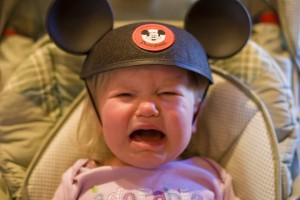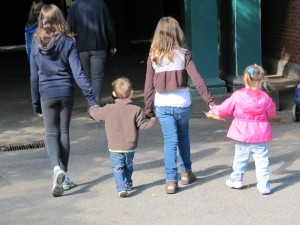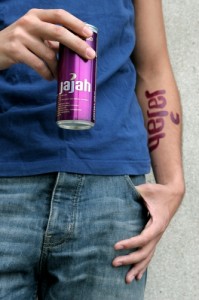It was a classic parenting pitfall, deliberately engineered by the evil geniuses at Disney World. I should have seen it coming, but I was taken totally off-guard.
My parents had generously flown our whole family down for a week at the amusement park, complete with on-site accommodations and meal package. It was a tremendous gift for all of us and an opportunity for plenty of memories and family fun.
We’d told our daughters (then 7 and 2) how lucky they were to go. We hadn’t done much airplane travel with them, so this was a really big deal. I had loaded up on Disney items on sale and at the dollar store before we went, and brought them along so I could dole out small gifts when we were there and avoid the vastly inflated prices in the park.
But what I hadn’t counted on was that every single big ride forced us to exit through the gift shop (thanks for the warning, Banksy). Adrenaline coursing through their little bodies, totally primed by the cleverly engineered multimedia experiences of spinning, bouncing and twirling through Disney worlds, our three daughters then found themselves face to face with retail versions of exactly the same Minnie Mouse, Princess or whatever animated character they had just seen in the ride. There were t-shirts, elaborate dress-up costumes, alarm clocks, stuffed animals, souvenir cups and a million other novelty items destined for brief, exhilarated enjoyment and then a quick descent into the eventual garage sale pile.
All around us, small children were either being indulged by credit card-carrying adults sporting strained smiles on their faces OR they were in various stages of consumption-related meltdown.
Somehow, our girls mostly managed to hold it together. They knew from experience that we don’t buy that kind of stuff, so they tended to gaze longingly at the shiny items without directly asking for them. When their grandmother indulged them one evening with some light-up Mickey Mouse wands, they were incredulous (“Mommy NEVER buys us things like this!”). But all around us, boys and girls either melted down or flashed their booty with exaggerated pride (at least until the next gift shop).
The whole experience made me think about the ways we teach our children the slippery concept of gratitude. As parents, we naturally want to them to truly appreciate all we do for them, a perspective that generally requires a certain amount of maturity and experience. But our culture surrounds them with constant pitches for more, bigger, better, newer, shinier, faster. And we tend to fall for it as much as they do (new iPad anyone? large screen plasma TV?).
Advertising and a culture of consumption instruct them on the ways we learn to define ourselves by our stuff. And since our stuff quickly gets outdated (replaced by newer versions), this culture requires a perpetual dissatisfaction, so that we are always motivated to buy newer, more stylish things.
If we have learned to express our love for our children through things, then it’s understandable that our kids have come to expect them as their due. The more we give them, the more they expect to be given. They feel entitled to have all they want. They become resentful and whiny when “everyone else in grade 2 has an iPod Touch.”
In her brilliant book The Blessing of a Skinned Knee, author Wendy Mogel tells parents not to worry too much about a lack of appreciation from our kids. Drawing from Jewish teachings, she says that deed is more important than creed: we need to teach our kids to use the right manners and expressions of appreciation, and the feeling of gratefulness will eventually follow.
She says that an impulse to do bad (yetzer hara) exists alongside the impulse to do good (yetzer tov). We need the former for the passions it can inflame in us, but we need to learn how to control it. Kids don’t know how to do this yet, and in teaching them the appropriate behaviors and self-control, they will become more inclined to be guided by the good instead of led astray by the evil.
It’s an interesting idea.
It’s the same reason we make our kids say “I’m sorry” when they really aren’t, or “thank you” without being particularly thankful. After going through the motions with these social norms for a while, do we not eventually internalize them?
After all, Mogel says our kids don’t respond to logic and reasoning (“you don’t need that plastic Disney Princess crown – you already have a lot of dress-up clothes”) or pious lecturing (“do you know how lucky you are to even be here in Disney World when kids all over the world have to go to bed hungry?”). She reminds us that parenting is about guidance, not consensus. When we say no, we can offer a short explanation and just move on, despite the wailing and tantrums that may ensue.
It’s good advice. Parents today often want to be their kids’ friends, and they try too hard to make them happy and be liked. In fact, being a good parent sometimes means making your kids unhappy and having them dislike you.
But what really struck me about her argument is recognizing that your kids’ lack of gratitude is not necessarily a personality flaw. It might just be a natural expression of their unrestrained zeal, their yetzer hara. If we can achieve a bit of critical distance (which is hard to do when faced with a loudly squalling child in the middle of a Disney gift shop), we might just see it as a normal part of childhood behavior.
While I do think there is some reason in her argument (no child is perfect – nor should we expect them to be), lack of gratitude must be consistently headed off with dialogue about what our children should be thankful for. Many parents find it very hard to exercise a disciplined reluctance to give in to most demands for consumer items (even if we can afford them). Itcan be challenging to make a clear distinction between expressions of love (time spent together, activities shared, hands held, fevered brows cooled, forgotten lunches driven to school) and buying stuff.
I think we need to say “no” to our kids sometimes simply for the experience of saying no. Because if they always get everything they want, why would they appreciate it? Gifts should (mostly) be saved for birthdays and holidays. Want a new skateboard? Save your allowance or wait for your birthday. Break your iPod? Dip into your savings to replace it or do without.
That’s what real life is like. And if we really love them, we will teach them that when they are young. One day they will be extremely thankful for that.





